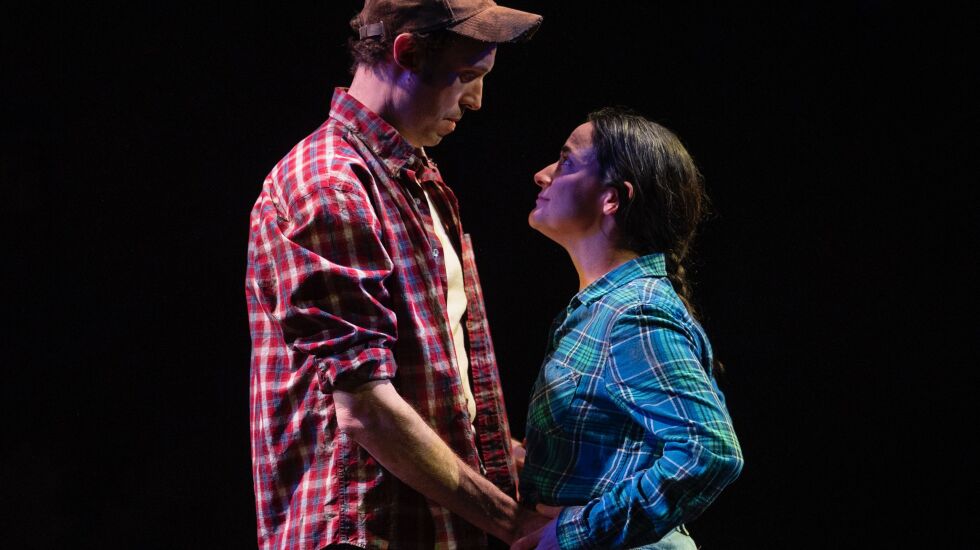
The eminent British playwright Caryl Churchill’s 1983 play “Fen” is receiving an extremely rare and impressive revival at the Court Theatre.
It’s a bit of a surprising programming choice. Churchill, now in her mid-80s and a perennial name on lists of potential Nobel recipients, has written plays more accessible to an American audience. “Cloud 9” is likely her most famous one, a humorously stylized, gender-bending take on colonialism. But there are others too, such as “Serious Money,” her evocative verse play about Wall Street (or, rather, the City of London), and I wonder if “Mad Forest,” about the Romanian revolution, might still have a lot to tell us.
But despite being an obvious challenge due to its social specificity and overt socialism, “Fen” proves genuinely worthy of unearthing. Thanks to a stellar production from Vanessa Stalling, directing a crazy-good cast, this 40-year-old play comes across as strikingly contemporary in its aesthetics and surprisingly relatable in its milieu.
The setting is extremely precise. The Fens refers to a geographic area in the east of England, where the marshy soil has provided fertile farmland, along with centuries of labor disputes between workers and owners or their intermediaries. The evolution towards corporate vertical integration — this is the Thatcher era, after all — means that it’s not always clear who even owns the land.
“Fen” follows a group of women who work the soil by hand, just like generations before them. They sit in the dirt — which covers the entire front part of the stage, probably half-a-foot deep — and dig out potatoes. They don’t get paid much and are treated like … dirt. They all know each other’s secrets in this fishbowl of a community. Sometimes they support each other. Other times they judge, often harshly.
The play proceeds in a series of short scenes, with a cast of five women and one man, the ensemble portraying some 20 characters ranging from children to the elderly. We go inside the characters’ homes, depicted mostly with just tables and chairs or stools or a prop like an ironing board standing on the dirt. And yet, except for the more stylized kid characters, the playing is realistic. In one scene, we even get a full-sized tractor. But as the play goes on, the supernatural starts to intrude.
By the time the 100-minute “Fen” was over, the most surprising comparisons that sprsng to my mind were the very current high-art horror films “Hereditary” and “Midsommer,” from director Ari Aster.
As in those tales, Churchill’s characters are put through the wringer; they suffer severely. There’s extreme emotional cruelty in the form of Angela (Morgan Lavenstein), so abusive to her stepdaughter Becky (Lizzie Bourne). There are dashes of more gothic horror, particularly when gender non-conforming troublemaker Nell (Elizabeth Laidlaw) spins a yarn about her grandfather witnessing a murder.

And at the storytelling core, there’s the painful story of Val (Cruz Gonzalez-Cadel), who leaves her husband and children after falling in love with fellow laborer Frank (Alex Goodrich). But in the separation from her children, her misery, and Frank’s, only seem to grow. Val has to choose between Frank and her kids (Genevieve VenJohnson and Lavenstein again). She can’t imagine surviving without either.
And there’s always that dirt, which starts out as an element of hyper-reality and then becomes more and more metaphorical. In “Fen,” Churchill reaches deep down into the community’s psyche, digging out the dreams and dark desires and intense frustrations that lie underneath, until the surface reality can no longer hold.
The play operates on so many levels — the sociopolitical, the psychological, the supernatural and, most of all, the theatrical.
It’s clear that Stalling was concerned about the audience being able to follow so many characters played by the same cast members. But between set designer Collette Pollard’s helpful projections of the names onto the cement-ish, prison-like back wall, costume designer Izumi Inaba’s expertly unobtrusive accessories and hair changes, and a focus from this fine ensemble on character physicality, the production provides plenty of clarity and nuance.
There is a weakness here, though. Stalling gets the chilliness, the emotional distance in the way people interrelate. But the Val-Frank scenes need to provide more contrast to that, to help us experience an intensity of connection that serves as the catalyst, the root if you will, of an explosive end.
Still, though, this is a show that takes you to — and underneath — a different time and place.







